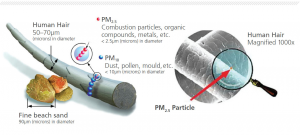Particulate Matter 2.5 (PM 2.5)
- Particulate matter, or PM, is the term for particles found in the air, including dust, dirt, soot, smoke, and liquid droplets.
- Particles can be suspended in the air for long periods of time.
- Some particles are large or dark enough to be seen as soot or smoke. Others are so small that individually they can only be detected with an electron microscope.
- Can be natural or anthropogenic
- Natural sources include volcanoes, forest fires, dust storms
- Anthropogenic causes include burning of fossil fuels in industries, vehicles, power plants, construction dust, burning of agricultural waste
- High temperatures usually cause pollutants like PM to be dissipated and move to the higher grounds. Hence, during the summers, the effect of these pollutants is less because of high dissipation and kinetic energy. But in winter, where they remain stagnant in form of aerosols, and may lead to serious respiratory issues.
- The problems is higher is Delhi because of more vehicles and also the distance from sea unlike Mumbai, Kolkata, etc.
- Particles less than 10 micro meters in diameter (PM10) pose a health concern because they can be inhaled into and accumulate in the respiratory system
- Particles less than 2.5 micro meters in diameter (PM2.5) are referred to as “fine” particles and are believed to pose the greatest health risks
- PM 2.5 can be absorbed in lungs and pass in to blood, thus, is very dangerous.
- Air Quality Index also measures PM 2.5
-
